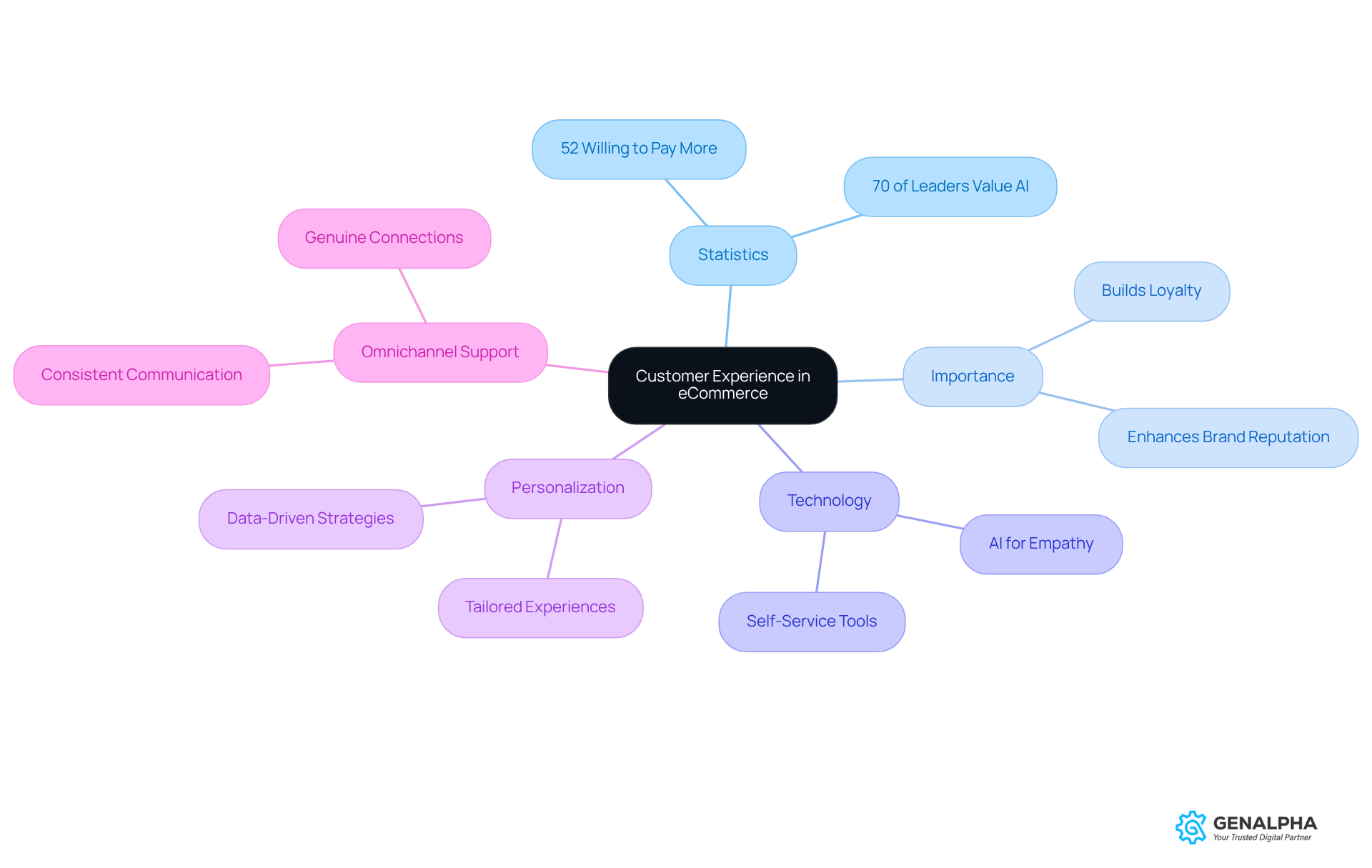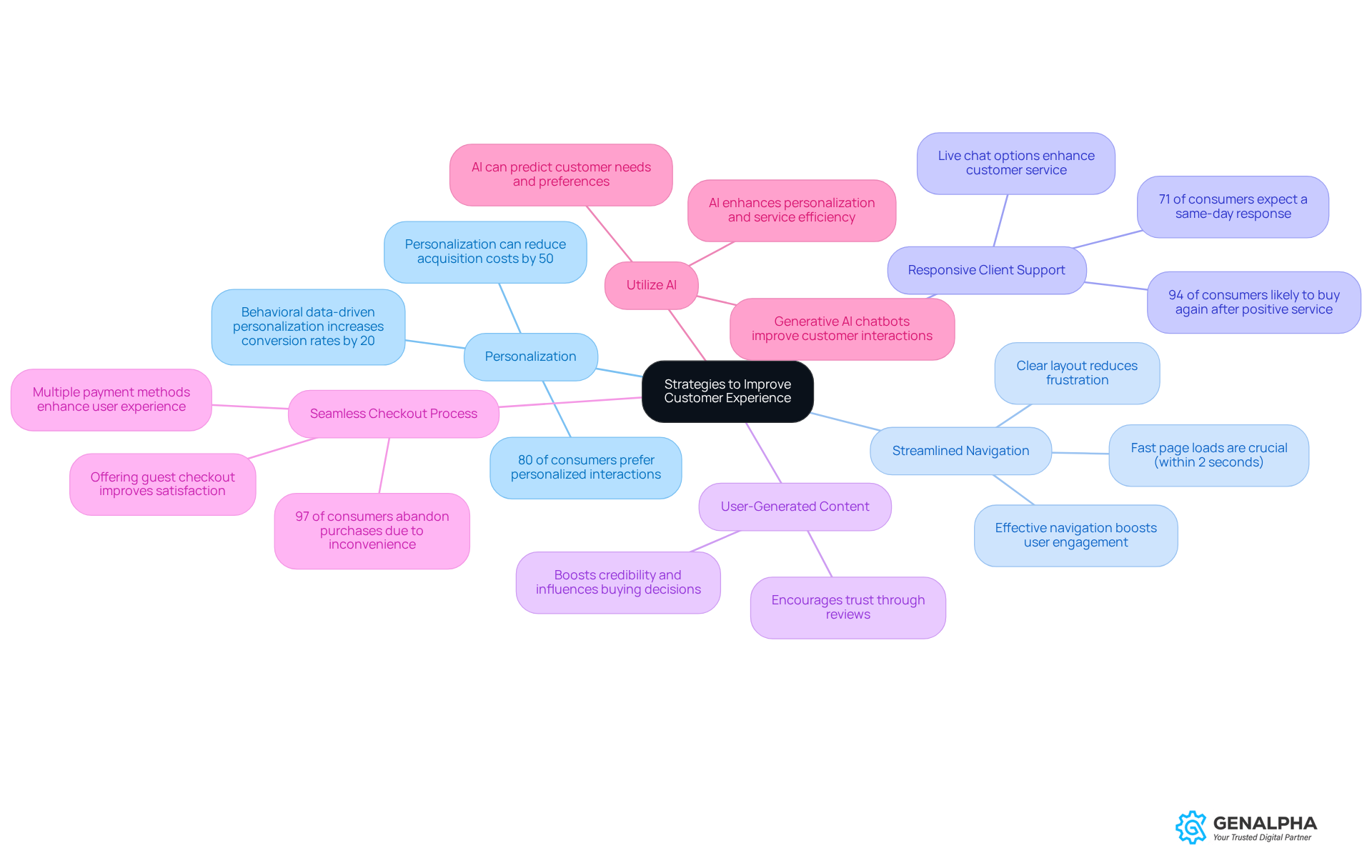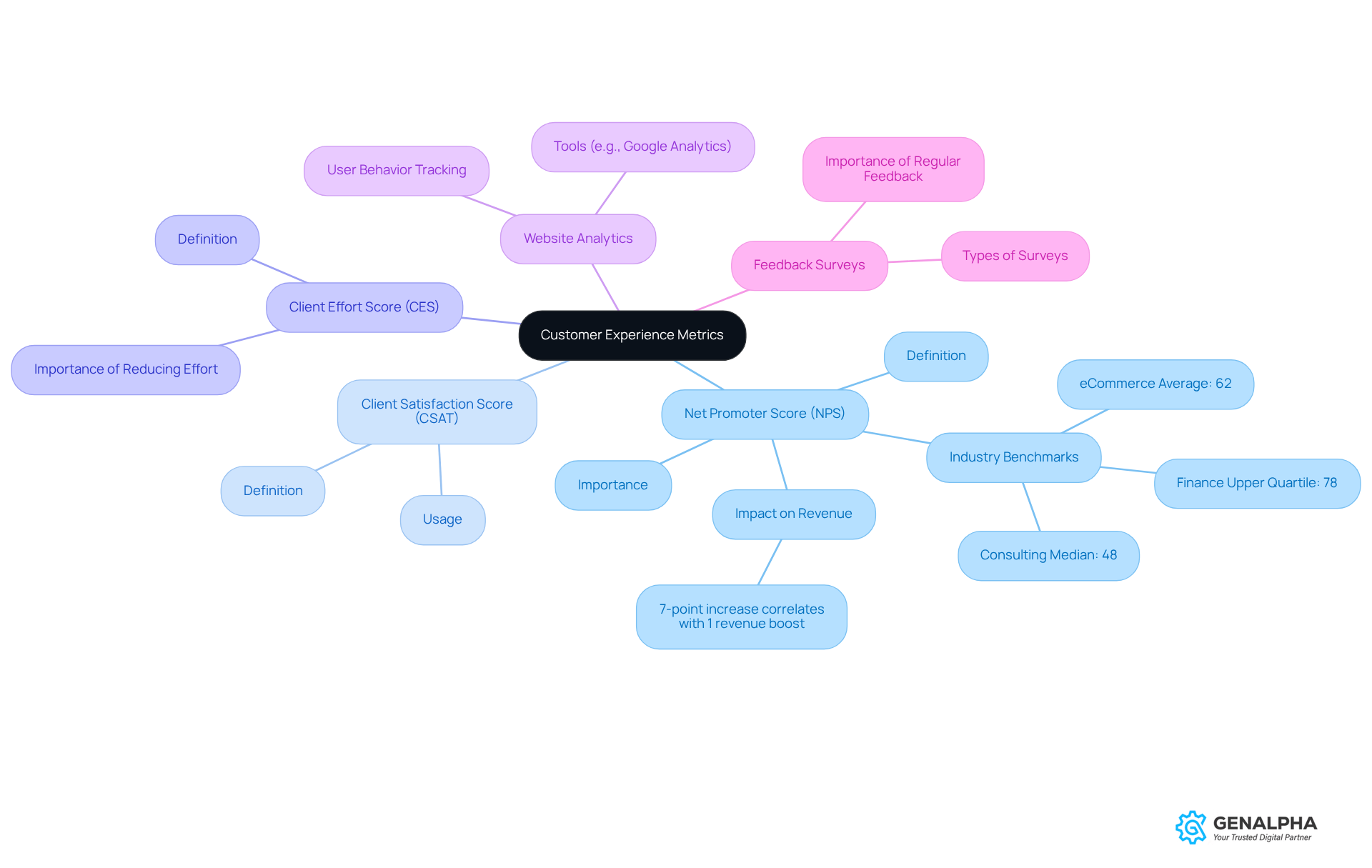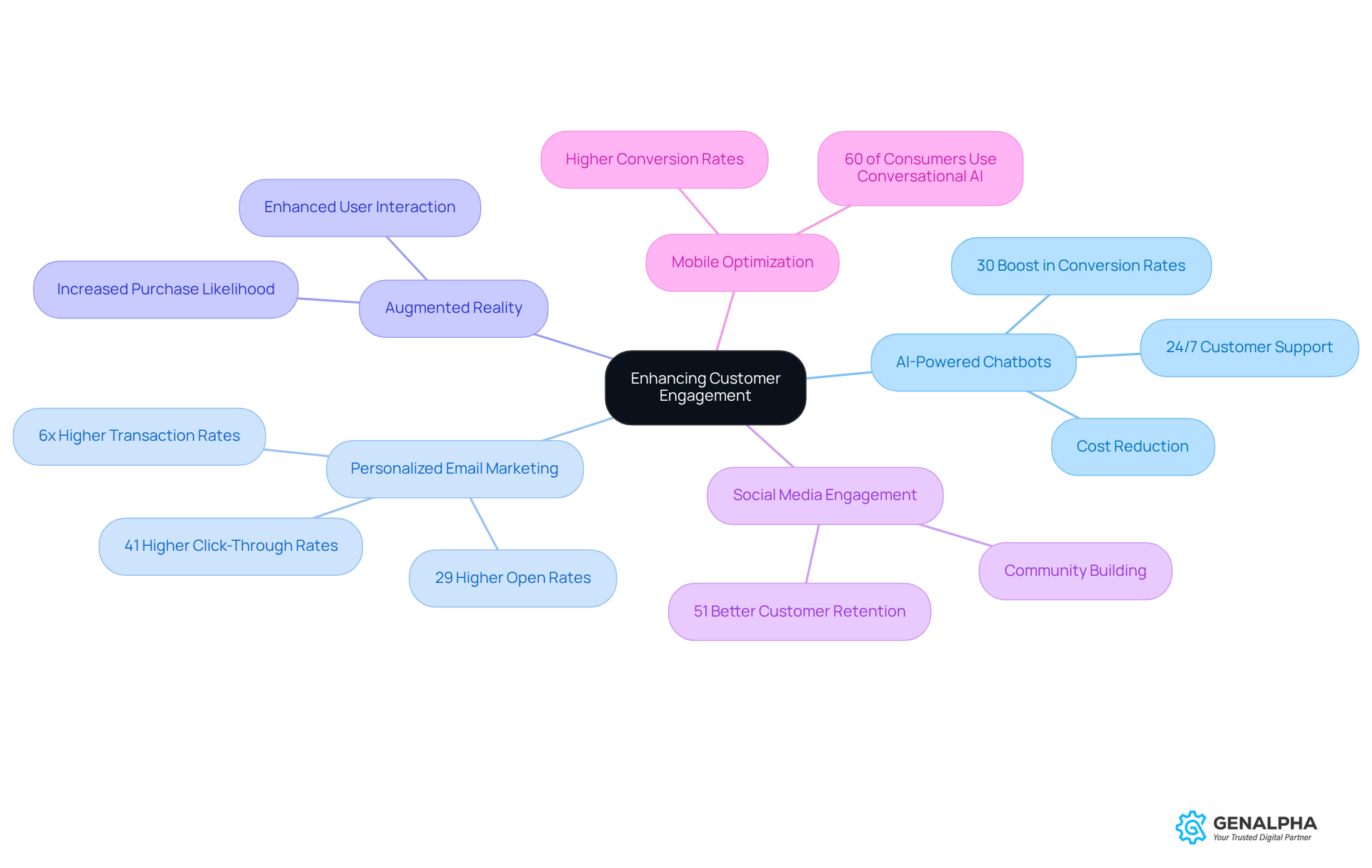Overview
Let's dive into some key strategies that can really boost customer experience in the world of eCommerce. We’re talking about:
- Personalization
- Streamlined navigation
- Responsive client support
- User-generated content
These aren’t just buzzwords; they’re backed by solid statistics and insights from experts. When businesses manage customer experience well, it leads to:
- Happier customers
- Greater loyalty
- Higher revenue
Who wouldn’t want that? So, how can you implement these strategies in your own business? Let’s explore!
Introduction
In the bustling world of eCommerce, customer experience has shifted from being just a nice-to-have to a must-have for success. Did you know that more than half of consumers are ready to pay extra for better interactions? This means businesses really need to step up their game when it comes to customer engagement.
But how can eCommerce brands tackle the tricky balance of meeting customer expectations and leveraging technology to build loyalty and boost sales? In this article, we’ll explore some actionable strategies that not only enhance the customer journey but also tackle the challenges of today’s demanding marketplace.
Understand the Importance of Customer Experience in eCommerce
In today's digital marketplace, client satisfaction (CX) has shifted from just a nice-to-have to a must-have for success. Did you know that 52% of consumers are willing to pay more for better interactions? That’s a clear sign that investing in CX pays off! And here’s something to think about: a single negative experience can push clients to switch brands. So, for eCommerce companies, prioritizing the customer experience for ecommerce is key.
A positive customer experience for ecommerce doesn’t just build loyalty and encourage repeat purchases; it also enhances your brand's reputation. Companies that excel in providing a superior customer experience for ecommerce often see their revenue outpace the competition. As we approach 2025, the spotlight on client experience is only going to get brighter. Consumers are seeking a personalized and seamless customer experience for ecommerce in all their shopping interactions.
Moreover, 70% of CX leaders believe that AI is making customer journeys feel more empathetic. This shows just how important technology is in enhancing CX. Companies should consider streamlining the buying process, possibly by offering one-click checkout for returning clients, to elevate the customer experience for ecommerce and take satisfaction to the next level.
Let’s not overlook the importance of omnichannel support. Clients expect consistent communication across various platforms. Ultimately, there’s a growing desire for between consumers and brands. So, why not prioritize authentic engagement? It’s a win-win for everyone!

Implement Proven Strategies to Improve Customer Experience
To enhance your customer experience in eCommerce, let’s explore some strategies that can really make a difference:
- Personalization: Imagine walking into a store where every item feels tailored just for you. That’s the power of personalization! By using data analytics to understand consumer behavior, you can offer suggestions that resonate with individual preferences. Did you know that 80% of consumers are more likely to buy from brands that provide personalized interactions across channels? As Aldona Krysiak-Adamczyk points out, grasping client expectations is key to improving the customer experience for ecommerce.
- Streamlined Navigation: Think about the last time you struggled to find something on a website. Frustrating, right? A well-organized site helps users quickly locate what they need, reducing frustration and abandonment rates. Effective navigation can boost user engagement, with studies showing that a clear layout and easy-to-find search features lead to higher conversion rates. Aldona Krysiak-Adamczyk emphasizes that a structured layout is crucial for improving the customer experience for ecommerce by minimizing client frustration.
- Responsive Client Support: Have you ever had a question and wished for immediate help? Implementing live chat options and ensuring prompt responses can transform customer service. With 94% of consumers stating that a increases their likelihood to buy again, responsive support can significantly enhance the customer experience for ecommerce, as well as satisfaction and loyalty.
- User-Generated Content: Who doesn’t trust a recommendation from a fellow shopper? Encouraging reviews and testimonials can sway buying decisions and build trust. Brands that leverage user-generated content often see a boost in credibility and improve the customer experience for ecommerce.
- Seamless Checkout Process: Picture this: you’ve filled your cart, but the checkout process is a hassle. Simplifying this step is crucial to improving the customer experience for ecommerce and reducing cart abandonment. Offering various payment methods and a guest checkout option can elevate customer satisfaction. Research indicates that 97% of consumers abandon purchases when the process is inconvenient, highlighting the need for a smooth checkout experience. Plus, ensuring compliance with data protection regulations like GDPR and CCPA is vital for building trust in your personalization efforts.
- Utilize AI: Imagine having a personal shopping assistant available 24/7. Integrating AI technologies can enhance client interactions by offering tailored suggestions and boosting overall service efficiency, keeping you aligned with current eCommerce trends.
By implementing these strategies, you can create a more engaging and satisfying customer experience for ecommerce for your customers. What steps will you take to enhance your eCommerce journey?

Measure and Analyze Customer Experience Effectively
To effectively measure and analyze customer experience, let’s explore some key metrics that can really make a difference:
- Net Promoter Score (NPS): Ever wondered how loyal your customers really are? This important metric does just that! It asks how likely individuals are to recommend your business to others. A strong NPS, usually above 45, shows you have a solid base of devoted clients who are eager to advocate for your brand. For eCommerce shops, the typical NPS hovers around 62, which serves as a great reference point for improving customer experience for ecommerce. Plus, did you know that an increase of 7 points in NPS can correlate with a 1% boost in revenue? That’s some serious financial impact!
- Client Satisfaction Score (CSAT): This score dives into how satisfied clients are with a specific interaction or their overall experience. High CSAT scores are vital for grasping immediate client sentiments and pinpointing areas for enhancement.
- Client Effort Score (CES): Think about how easy it is for your clients to engage with your business. This metric evaluates just that, shining a light on potential friction points. By minimizing client effort, you can significantly boost satisfaction and loyalty.
- Website Analytics: Tools like Google Analytics are your best friends here. They help track user behavior on your site, allowing you to recognize drop-off locations and areas ripe for improvement. A smoother shopping journey is essential for improving customer experience for ecommerce and keeping clients happy.
- Feedback Surveys: Don’t shy away from asking for opinions! Regularly request feedback through surveys to gain insights into client interactions and expectations. As noted by Qualtrics, NPS could be the most influential KPI in your client satisfaction toolkit. Establishing efficient feedback systems can lead to practical insights that drive ongoing enhancement in client satisfaction. Remember, it’s crucial to focus on the overall customer experience for ecommerce, not just the NPS score itself. This way, you can tackle throughout the client journey.
So, how are you measuring up? Let’s keep the conversation going and explore how these metrics can elevate your customer experience!

Leverage Technology to Enhance Customer Engagement
Using technology is super important for improving the customer experience for ecommerce and boosting client engagement. Let’s dive into some effective strategies:
- AI-Powered Chatbots: Imagine having chatbots ready to help your clients 24/7! They can tackle common questions and guide shoppers through their experience. With quick replies and personalized suggestions, these chatbots not only enhance client satisfaction but also cut down on operational costs. Plus, conversational AI can boost conversion rates by 30% by engaging people in real time!
- Personalized Email Marketing: How about utilizing client data to send out targeted email campaigns? By aligning with individual preferences and behaviors, tailored emails can achieve open rates that are 29% higher and click-through rates that are 41% better than regular messages. This approach fosters deeper connections with clients and drives engagement.
- Augmented Reality (AR): Ever thought about how AR can transform shopping? By allowing users to visualize products in their own spaces, AR makes the shopping experience much more engaging. Not only does it enhance user interaction, but it also increases the likelihood of purchase by helping clients see how products fit into their lives. Imagine combining AR with chatbots for a seamless experience that really boosts engagement!
- Social Media Engagement: Let’s not forget about social media! It’s a fantastic way to connect with clients, gather feedback, and promote products. Building a community around your brand on these platforms can greatly enhance loyalty and engagement. Studies indicate that brands focused on their clients retain individuals 51% better than others, highlighting the importance of developing a community.
- Mobile Optimization: Is your eCommerce site mobile-friendly? With so much shopping happening on mobile devices, ensuring a is crucial for client satisfaction. This can lead to higher conversion rates, especially since over 60% of consumers are using conversational AI tools for online shopping. Optimizing for mobile is more important than ever!
By implementing these strategies, businesses can enhance the customer experience for ecommerce, creating a more engaging and satisfying shopping experience that ultimately drives growth and customer loyalty. What are you waiting for? Let’s get started on enhancing client engagement today!

Conclusion
In the fast-paced world of eCommerce, focusing on customer experience isn't just a nice-to-have—it's essential for building loyalty and boosting sales. Think about it: when you enhance customer interactions, not only do you see an uptick in revenue, but your brand's reputation also gets a nice little boost. Today’s consumers are craving personalized and seamless shopping experiences, which means businesses need to adapt and innovate to keep up with these expectations.
So, what can you do to improve customer experience? Here are some key strategies:
- Personalization
- Streamlined navigation
- Responsive client support
- User-generated content
- A seamless checkout process
- Leveraging AI technologies
Each of these tactics tackles specific pain points in the customer journey, ultimately leading to happier customers and more repeat purchases. Plus, don’t forget to measure your customer experience with metrics like NPS, CSAT, and CES. These insights can be gold for guiding your ongoing improvements.
As the eCommerce landscape keeps evolving, embracing technology and building genuine connections with customers will be crucial. By implementing these strategies and putting customers at the center of your practices, you can enhance their experience and set your business up for long-term success in a rapidly changing market. The message is clear: invest in customer experience now, and you’ll reap the rewards of loyalty and growth in the future.
Frequently Asked Questions
Why is customer experience (CX) important in eCommerce?
Customer experience is crucial in eCommerce because it has shifted from being a nice-to-have to a must-have for success. A positive CX builds loyalty, encourages repeat purchases, and enhances a brand's reputation, leading to increased revenue.
What percentage of consumers are willing to pay more for better customer interactions?
According to the article, 52% of consumers are willing to pay more for better interactions.
How can a negative customer experience impact a brand?
A single negative experience can push clients to switch brands, highlighting the importance of prioritizing customer experience in eCommerce.
What trends are expected in customer experience as we approach 2025?
As we approach 2025, there will be a growing focus on personalized and seamless customer experiences in all shopping interactions.
How does technology, specifically AI, impact customer experience?
70% of CX leaders believe that AI is making customer journeys feel more empathetic, indicating that technology plays a significant role in enhancing customer experience.
What are some strategies companies can use to improve customer experience?
Companies can streamline the buying process, such as offering one-click checkout for returning clients, to elevate the customer experience.
Why is omnichannel support important for customer experience?
Omnichannel support is important because clients expect consistent communication across various platforms, which helps create a more cohesive and satisfying customer experience.
What is the significance of authentic engagement between consumers and brands?
There is a growing desire for genuine connections between consumers and brands, and prioritizing authentic engagement can lead to positive outcomes for both parties.




